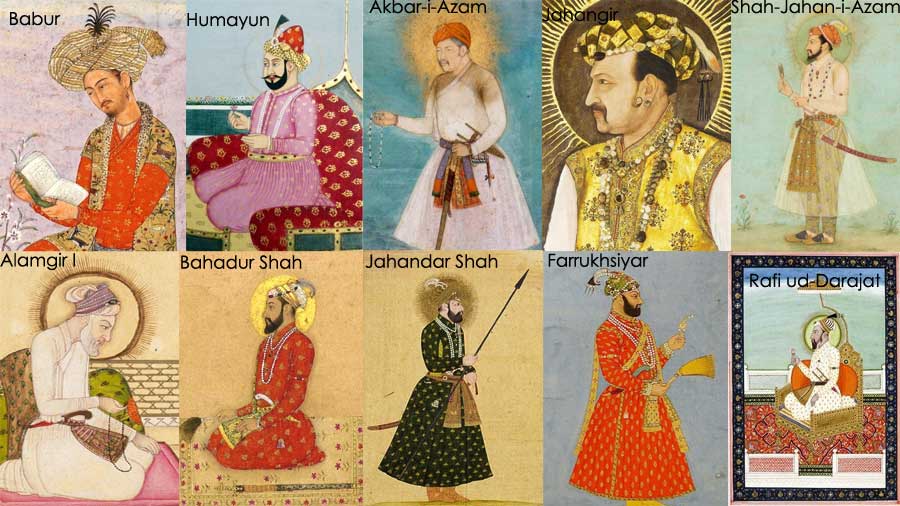History of The Mughal Empire
The Mughal Empire was an Islamic Turkic-Mongol empire that began in 1526, ruled the Indian subcontinent in the late 17th and early 18th centuries, and ended in the mid-19th century. The Mughal emperors were of the Turko-Mongol generation of Timur dynasty and developed a very sophisticated mixed Indo-Persian culture. At the height of its power, around 1700, it controlled much of the Indian subcontinent – extending from present-day Bangladesh in the east to Balochistan in the west, and from Kashmir in the north to the Kaveri Valley in the south.
The population of this empire at that time was estimated to be between 11 and 13 crores. Its power declined rapidly after 1725. The last emperor of an empire weakened by succession strife, agrarian distress, local rebellions, the height of religious intolerance and British colonialism was Bahadur Zafar Shah, whose rule was confined to the city of Delhi. The British kept him imprisoned and exiled by the British to Myanmar after the Indian Rebellion of 1857. The reign of the empire began with the accession of Jalaluddin Muhammad Akbar, who became famous as Akbar the Great, in 1556, and ended with the death of Emperor Aurangzeb, although the empire lasted another 150 years. Let us know about the Mughal ruler and his reign:-
The details of the reign of the Mughal emperors are tabulated below:
| Name (birth name) | Birth and death | Reign |
| Babur (Zahiruddin Muhammad) | 23 February 1483-5 January 1531 (age 47) | 30 April 1526 – 26 December 1530 |
| Humayun (Naseeruddin Muhammad Humayun) | 17 March 1508-27 January 1556 (age 47) | 26 December 1530 – 17 May 1540 |
| Akbar-e-Azam (Jalaluddin Muhammad) | 14 October 1542-27 October 1605 (age 63) | 27 January 1556 – 27 October 1605 |
| Jahangir (Nooruddin Muhammad Salim) | 20 September 1569-8 November 1627 (age 58) | 27 October 1605 – 8 November 1627 |
| Shah Jahan-e-Azam (Shahabuddin Muhammad Khurram) | 5 January 1592-22 January 1666 (age 74) | 8 November 1627 – 31 July 1658 |
| Alamgir (Muinuddin Muhammad) | 4 November 1618-3 March 1707 (age 88) | 31 July 1658 – 3 March 1707 |
| Bahadur Shah (Qutubuddin Muhammad Muazzam) | 14 October 1643-27 February 1712 (age 68) | 19 June 1707 – 27 February 1712 |
| Jahandar Shah (Mazuddin Jahandar Shah Bahadur) | 9 May 1661-11 February 1713 (age 51) | 27 February 1712 – 11 February 1713 |
| Farrukhshiyar (Farrukhshiyar) | 20 August 1685-28 February 1719 (age 33) | 11 January 1713 – 28 February 1719 |
| Rafi ul-Darjat (Rafi ul-Darjat) | 30 November 1699-6 June 1719 (age 19) | 28 February – 6 June 1719 |
| Shah Jahan II (Rafi ud-Daulat) | June 1696-19 September 1719 (age 23) | 6 June 1719 – 19 September 1719 |
| Muhammad Shah (Roshan Akhtar Bahadur) | 17 August 1702-26 April 1748 (age 45) | 27 September 1719 – 26 April 1748 |
| Ahmed Shah Bahadur (Ahmed Shah Bahadur) | 23 December 1725 – 1 January 1775 (age 49) | 26 April 1748 – 2 June 1754 |
| Alamgir II (Azizuddin) | 6 June 1699-29 November 1759 (age 60) | 2 June 1754 – 29 November 1759 |
| Shah Jahan III (Muhi-ul-Millat) | 1711-1772 (age 61) | 10 December 1759 – 10 October 1760 |
| Shah Alam II (Ali Gauhar) | 25 June 1728–19 November 1806 (age 78) | 24 December 1760 – 19 November 1806 |
Now practice related questions and see what you learnt?
☞ Mughal Empire GK Questions and Answers 🔗
Read also:
- List of Sufi saints and Architectures 🔗
- List of Mughal Architecture Works and their Builders 🔗
- French East India Company: History, Arrival, Establishment and Confrontation 🔗
Mughal Empire FAQs:
After Babur, his son Humayun sat on the Mughal throne. Humayun, whose full name was Nasiruddin Muhammad Humayun, was born in 1508 AD. Humayun had the honor of becoming the official ruler of the Mughal Empire when he ascended the Mughal throne in 1504 AD, following the death of his father Babur.
Sir Thomas Roe came to the court of Mughal Emperor Jahangir. Thomas Roe was an English merchant and diplomat who lived in India from 1608 AD to 1615 AD as a representative of the East India Company. He was sent to Jahangir's court when he became emperor.
The first Mughal emperor of India was Babur. He was the founder of the Mughal Empire and in 1526 he defeated Ibrahim Lodi in the Battle of Panipat and got the rule of the Delhi Sultanate.
The court language of the Mughal rulers was Persian. Persian, an Iranian language, was the official and administrative language of the Mughal Empire. This language was used by the Mughal emperors and their court officials from Babur to Akbar, Jahangir, Shah Jahan and probably till now.
In the Mughal period, Shah Jahan is said to be illiterate. Shah Jahan was a great Mughal emperor who is famous for building the Taj Mahal. However, Shah Jahan lacked education during his reign and did not complete his studies, due to which he did not know the alphabet.

